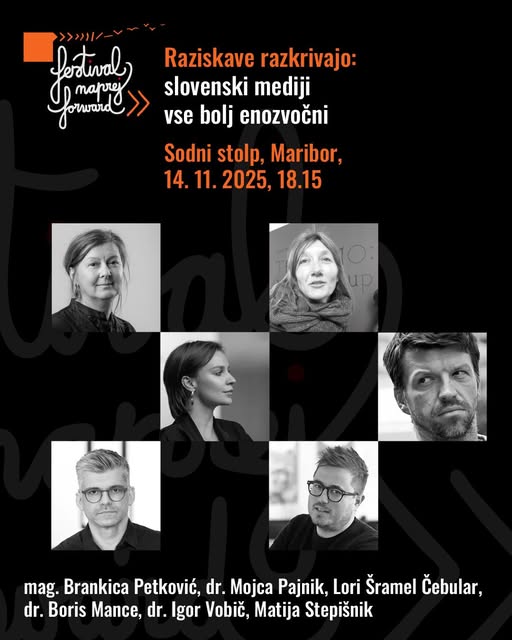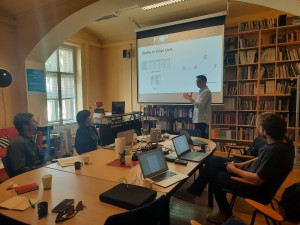Research reveals: Slovenian media increasingly one-voiced
5. 11. 2025 | Media

As part of the Naprej / Forward festival, on Friday, November 14, 2025, at 6:15 p.m. in the Sodni stolp (Judgment Tower) in Maribor, there will be a presentation of three research projects carried out by the Peace Institute and the Faculty of Social Sciences at the University of Ljubljana. Together, these studies provide a comprehensive overview of the state of the media and democracy in Slovenia.
The MeDeMAP study examines the role of the media in democracy, production conditions, and audience relations, highlighting journalists’ strong commitment to providing credible information. At the same time, it reveals a widespread sense of alienation and distrust in the media, and above all, public doubt as to whether, under current systemic conditions, the democratic role of the media is even possible. The analysis of news diversity shows that the apparent pluralism conceals a high degree of content homogeneity shaped by power relations, the central role of the Slovenian Press Agency, and the dominance of political sources. The AFEMED study analyzes the structural changes in the media system between 2010 and 2022, uncovering ownership concentration, the withdrawal of foreign investors, and the strengthening of politically connected media networks. Together, the studies reveal that the conditions for democratic, plural, and independent media activity are increasingly endangered—yet there remains a strong societal desire to rebuild trust in the media as a public good.
MeDeMAP
The MeDeMAP (Mapping Media for Future Democracies) project focuses on the role of the media in democracy, examining media regulation, the structure of the media landscape, and the democratic functions of the media from the perspectives of production and audiences. The research, conducted in ten EU countries, is implemented in Slovenia by the Peace Institute.
Production conditions for fulfilling the media’s democratic functions are illuminated through interviews with editors and journalists, who express a strong principled commitment to providing credible information, ensuring government accountability, pluralism, and political participation. In practice, this commitment is constrained by financial insecurity, ownership pressures, newsroom downsizing, and political influence, which contribute to polarization, erosion of trust, and attacks on journalists.
Focus groups with citizens reveal a widespread sense of alienation and distrust in the media—not necessarily final or unequivocal—but a deep doubt about whether the democratic role of the media is even possible under current systemic conditions. A distinctive feature of the project is the organization of citizens’ assemblies on media and democracy, which demonstrated that the desire for media freedom and democracy remains alive.
The Slovenian citizens’ assembly translated this vision into concrete demands: stricter regulation of media ownership and financing, special status and support for socially responsible and independent media, stable public funding for journalistic employment, in-depth and ethical journalism, enhanced media literacy, and dialogue between the media and the public—with a clear goal: to restore trust in the media as a public good.
More information: https://www.medemap.eu and https://www.mirovni-institut.si/mediji-demokracija/
Presented by Brankica Petković.
AFEMED
The AFEMED (Affective Media: Transformations of Public Communication) study analyzes media transformations in Slovenia between 2010 and 2022, focusing on the strategies of horizontal and vertical integration of media groups that have led to a highly concentrated market. It situates the Slovenian media system within broader regional trends in Central and Eastern Europe, characterized by the withdrawal of Western media owners, the emergence of domestic and Eastern European oligarchs, and the expansion of party-affiliated media networks.
Findings from the network analysis of ownership connections show a decline in print media, growth of online media, and increasing ownership consolidation concentrated among a small number of individuals. The results highlight dominant media groups—from local conglomerates and regional media giants to politically connected networks—and their influential role in shaping Slovenia’s media landscape.
More information: https://www.mirovni-institut.si/afektivni-mediji/
Homogenization of News in Slovenia’s Media Landscape
This research goes beyond the simplified binary logic of earlier studies on media content pluralism (e.g., left–right, liberal–conservative, or pro-government–neutral–anti-government) and identifies patterns of news pluralization and homogenization, explaining news diversity through fundamental power relations within Slovenia’s media landscape.
The analysis included 13,207 journalistic pieces from 141 media outlets and found that apparent institutional pluralism conceals high levels of content homogeneity, significantly shaped by the central role of the Slovenian Press Agency. Patterns of homogenization are further reinforced by ownership, regional, and ideological links among media.
At the same time, the study finds that political and other official sources strongly dominate news content, while civil society, citizens, and experts are significantly underrepresented. News diversity in Slovenia thus largely reflects underlying power relations that determine who gets to speak in the symbolic space of the media and which perspectives prevail. This confirms the normative importance of news diversity as a prerequisite for the democratization of public communication and underscores the need for structural changes that would enable a more inclusive media landscape.
Presented by Igor Vobič and Boris Mance.
Moderated by Matija Stepišnik.





